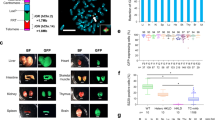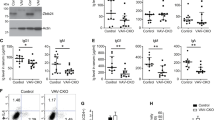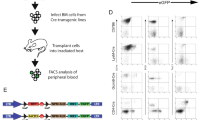Abstract
The striking number of human and murine immunodeficiency disorders which map to the X chromosome (Table 1) suggests that genes localized on this chromosome must have important roles in lymphocyte development. At least seven distinct disorders in the human and two in the mouse disrupt lymphocyte maturation, particularly that of B cells, at characteristic stages1,2. As functional genes mapping to the X chromosome in one mammal are found on the X chromosome in all other mammals3, the same genes regulating lymphocyte development are expected to be found on the X chromosome in mouse and man. Investigations into the possible mechanisms of these X-linked disorders have been hampered by the lack of molecular probes for the genes or gene products affected; because of this, and the possibility of correlating one or more of the several hundred B- or T-cell-specific genes4 with a specific mutation, we surveyed 15 different B- and T-cell-specific cDNA clones for localization to the X chromosome. We report here the characterization of one of these murine cDNA clones, which hybridizes with a large, X-linked gene family, designated XLR (X-linked, lymphocyte-regulated). We show that the XLR gene family is closely linked to the X-linked immunodeficiency described in the CBA/N mouse strain (xid)5, by restriction fragment length polymorphism (RFLP) analysis of DNA from mice congeneic for xid. This finding, together with data on the expression of the XLR locus in B cells (see accompanying paper6), indicates that this gene family either includes the locus defined by the xid mutation or is adjacent to it in a gene complex which may be important in lymphocyte differentiation.
This is a preview of subscription content, access via your institution
Access options
Subscribe to this journal
Receive 51 print issues and online access
$199.00 per year
only $3.90 per issue
Buy this article
- Purchase on Springer Link
- Instant access to full article PDF
Prices may be subject to local taxes which are calculated during checkout
Similar content being viewed by others
References
Waldmann, T. A., Strober, W. & Blaese, R. M. in Clinical Immunology Vol. 1, 314–375 (W. B. Saunders, Philadelphia, 1980).
Scher, I. Adv. Immun. 33, 1–71 (1982).
Ohno, S. A. Rev. Genet. 3, 495–524 (1969).
Davis, M. M. et al. UCLA Symp. 24, 215–220 (1982).
Amsbaugh, D. F. et al. J. exp. Med. 136, 931–949 (1972).
Cohen, D. I., Steinberg, A. D., Paul, W. E. & Davis, M. M. Nature 314, 372–374 (1985).
Davis, M. M. et al. Proc. natn. Acad. Sci. U.S.A. 81, 2194–2198 (1984).
Southern, E. M. J. molec. Biol. 98, 503–517 (1975).
Shin, H. S., Stavnezer, J., Artzt, K. & Bennett, D. Cell 29, 969–976 (1982).
Silver, L. M. Cell 29, 961–968 (1982).
Steinmetz, M., Winoto, A., Minard, K. & Hood, L. Cell 28, 489–498 (1982).
Goeddel, D. V. et al. Nature 290, 20–26 (1981).
Steffen, D. & Weinberg, R. A. Cell 15, 1003–1010 (1978).
Klein, J. in Biology of the Mouse Histocompatibility Complex, 16–39 (Springer, New York, 1975).
Owerbach, D. et al. Proc. natn. Acad. Sci. U.S.A. 78, 3123–3127 (1981).
Paul, W. E. et al. in Cells of Immunoglobulin Synthesis, 383–396 (Academic, New York, 1979).
Mosier, D. E. et al. Immun. Rev. 37, 89–104 (1977).
Ahmed, A. et al. J. exp. Med. 145, 101–110 (1977).
Takatsu, K., Tominaga, A. & Hamaoka, T. J. Immun. 124, 2414–2422 (1980).
Takatsu, K. et al. Nature 292, 360–362 (1981).
Orkin, J. H. et al. Nature 296, 627–631 (1982).
Giannelli, F. et al. Nature 303, 181–182 (1983).
Wiginton, D. A. et al. Proc. natn. Acad. Sci. U.S.A. 80, 7481–7485 (1983).
Steinberg, E. B. et al. J. Immun. 131, 2789–2795 (1983).
Smith, H. R., Chused, T. M. & Steinberg, A. D. J. Immun. 131, 1257–1262 (1983).
Steinberg, A. D. et al. Immun. Rev. 55, 121–154 (1981).
Jones, R. W., Old, J. M., Trent, R. J. & Weatherall, D. J. Nature 291, 39–44 (1981).
Maniatis, T., Fritsch, E. F. & Sambrook, J. in Molecular Cloning, 447 (Cold Spring Harbor Laboratory, New York, 1982).
D'Eustachio, P., Bothwell, A. L. M., Tokaro, T. K., Baltimore, D. & Ruddle, F. H. J. exp. Med. 153, 793–800 (1981).
Goff, S., D'Eustachio, P., Ruddle, F. H. & Baltimore, D. Science 218, 1317–1319 (1982).
Author information
Authors and Affiliations
Rights and permissions
About this article
Cite this article
Cohen, D., Hedrick, S., Nielsen, E. et al. Isolation of a cDNA clone corresponding to an X-linked gene family (XLR) closely linked to the murine immunodeficiency disorder xid. Nature 314, 369–372 (1985). https://doi.org/10.1038/314369a0
Received:
Accepted:
Issue Date:
DOI: https://doi.org/10.1038/314369a0
This article is cited by
-
Identification of novel Y chromosome encoded transcripts by testis transcriptome analysis of mice with deletions of the Y chromosome long arm
Genome Biology (2005)
-
Identification of a cluster of X-linked imprinted genes in mice
Nature Genetics (2005)
-
A putative human equivalent of the murine Xlr (X-linked, lymphocyte-regulated) protein
Mammalian Genome (1995)
-
068 Isolation of a possible human counterpart to the murine XLR genes
Fresenius' Journal of Analytical Chemistry (1992)
-
Immunogenetics: Lymphocyte development genes and immunodeficiency disease
Nature (1985)
Comments
By submitting a comment you agree to abide by our Terms and Community Guidelines. If you find something abusive or that does not comply with our terms or guidelines please flag it as inappropriate.



